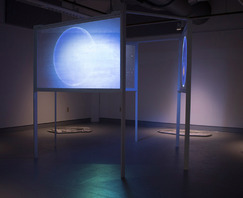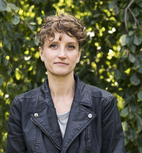
Drawing Courses
Pro Pract: Industry
Course No. PPEL 398B Credits: 3.0
This course provides an overview of the environment surrounding the business of art and design, and the practice of the individual. One of the two class meeting per week is a core lecture series that covers self-promotion, networking, ethics, intellectual property, contracts, professional development, and guidance by practicing professionals. During the other weekly meeting, students attend a breakout session for the specific course in which they are enrolled. The breakout session for this course, Professional Practices: Industry supports student preparation to become an integral part of a commercial organization by providing an understanding of corporate methods and practices. 3 credits.
Professional Practices: Studio to Gallery
Course No. PPEL 398C Credits: 3.0
This course provides an overview of the environment surrounding the business of art and design, and the practice of the individual. One of the two class meeting per week is a core lecture series that covers self-promotion, networking, ethics, intellectual property, contracts, professional development, and guidance by practicing professionals. During the other weekly meeting, students attend a breakout session for the specific course in which they are enrolled. The breakout session for this course, Professional Practices: Studio to Gallery focuses on the complexities of a professional artist’s studio practice by examining interactions with gallery directors, museum curators, preparators, conservators, and marketing professionals. 3 credits.
Pro Pract: Studio to Gallery
Course No. PPEL 398C Credits: 3.0
This course provides an overview of the environment surrounding the business of art and design, and the practice of the individual. One of the two class meeting per week is a core lecture series that covers self-promotion, networking, ethics, intellectual property, contracts, professional development, and guidance by practicing professionals. During the other weekly meeting, students attend a breakout session for the specific course in which they are enrolled. The breakout session for this course, Professional Practices: Studio to Gallery focuses on the complexities of a professional artist’s studio practice by examining interactions with gallery directors, museum curators, preparators, conservators, and marketing professionals. 3 credits.
Image + Form I
Course No. VAT 200 Credits: 3.0
Image/Form promotes a general understanding how images work and are developed, which is a fundamental aspect of the Visual Arts. The course introduces the students to the various means by which images can be rendered, such as by drawing, painting, carving, embroidering, etching, etc., as well as by digital means, by appropriation, and by the use of ready-mades. The students are also introduced to the diverse ways in which images and forms can be manipulated, or manifested conceptually and materially by exploring the inter-relation between 2 and 3 dimensions, as well as in time-based media by the use of collage or assemblage. In doing this, we introduce them to the concept that an image’s “form,” consisting of its physical and spatial qualities, as well as the technical qualities of their chosen mode of production, is part of its content. By these means they are introduced to practical and semiotic nature of images and their production in the context of the contemporary by means of assignments, readings, discussions, and studio critiques. Open as elective to all majors. This course is required for all sophomore students in Visual Arts. 3 credits.
The Artist’s Practice in Context
Course No. VAT 200X-300X-400X Credits: 1.5
As a complement to the Professional Practices course, “The Artist’s Practice in Context” is specifically designed for Visual Arts students. The course takes an intimate look at the professional practices of artists working in major metropolitan areas such as New York City, Chicago, Los Angeles or Berlin. As part of the course students examine the realities of maintaining a professional practice within the context of this focus community. Students, guided and directed by faculty, are immersed in that community through such activities as studio visits; meetings area arts professionals and art venues. Open to all. Students must be 18 years old or over and must sign a waiver to travel with the group. Course may be taken more than once for additional credit. 1.5 credits.
Image + Form II: Reproducibility
Course No. VAT 202 Credits: 3.0
Though we often think of artworks as unique, this is not an intrinsic or inherent quality of the work itself, but the result of the choice of media. Consequently, since the Renaissance and the advent of Printmaking, the printing press, and bronze casting, multiplicity and reproduction have been a part of Western culture. The machine age, photo-reproduction, lithography, industrial standardization, modularity, fabrication, and multiplicity became part of artistic practice. Prints, posters, ready-mades, objects, books, comics, and designed utilitarian objects editions, multiples, modules, and reproductions are now a significant aspect of contemporary art making which abandons the notion of the unique work. Making works of this kind requires the artist to take into consideration how the act of reproduction, or replication constitutes part of their work’s form and content. 3 credits.
Collage + Assemblage
Course No. VAT 212 Credits: 3.0
Collage and Assemblage are among the most radical innovations of the early 20th century and these forms remain relevant today as sources for innovation and experimentation. Each of these forms acknowledges the fracture of contemporary life and the ongoing need for new means of expression. This course will explore the relationship between collage and assemblage and various disciplines within the visual arts including Painting, Print, and Drawing. Students will learn to discern the significantly different effects and content of the wide range of strategies these approaches encompass. Through classroom discussion, lectures, readings, critiques and studio work students will explore the possibilities available through collage and assemblage. Emphasis will be given to the historical and contemporary studio practices associated with collage and assemblage. This course is open to all students from all majors. Students will be encouraged to apply their area of expertise to the studio work. 3 credits.
Installation + Constructed Objects
Course No. VAT 226 Credits: 3.0
This course is a special topic course designed to cover the design, construction and lighting of installations, stage sets, and performance spaces. Students will investigate contemporary applications and approaches to subjects specifically composed for the camera and document installations that exist outside of the studio environment, with an emphasis on the genre’s relationship to historical and contemporary theatre. Workshops include cameras, studio lighting, basic electricity and carpentry, with an emphasis on scenery design. Students will plan and create small-scale models of stage designs; scale up these designs, and document their design. This course is designed for the Photography major and any students working in installation or Industrial Design but is open to all majors. 3 credits.
Meet Your Faculty view all
Amber Kempthorn
Assistant Professor
Amber Kempthorn explores time and nostalgia through drawing. Her work has been exhibited across the U.S. and w...more
Featured Student Work view all

Our connections are your connections.
While at CIA, you'll learn from the masters through our rigorous, world-class curriculum and connect with working professionals to begin your career.


